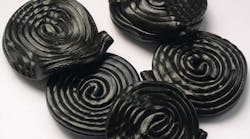Liquorice root has been used in Europe since prehistoric times, and is well documented beginning with the ancient Greeks.(1) It is an extract of the plant Glycyrrhiza, whose name is derived from the Greek word "glykos," meaning sweet, and "rhiza," meaning root.(2) Licorice extracts and its principle component, glycyrrhizin, have extensive use in foods, tobacco and in both traditional and herbal medicine.(3) In the USA, it is recognized as a safe flavoring agent and is accepted in many countries as a healthy natural substance. As a result, there is a high level of use of licorice and glycyrrhizin in the US. Biochemical studies indicate that glycyrrhizinates inhibit 11beta-hydroxysteroid dehydrogenase, the enzyme responsible for inactivating cortisol.(3) As a result, the continuous, high-level exposure to glycyrrhizin compounds can produce hypermineralocorticoid-like effects in both animals and humans. These effects are reversible upon withdrawal of licorice or glycyrrhizin. Some in vivo and clinical studies have reported beneficial effects of both licorice and glycyrrhizin consumption, including anti-ulcer, anti-viral, and hepatoprotective responses.(4)
The bottom line is that people with history of cardiac disease should be strongly warned about excess licorice intake. Those who are more susceptible to arrhythmias should minimize their licorice intake especially if they are concurrently on medicines that lower potassium level, such as thiazide or loop diuretics. Those with congestive heart failure or resistant hypertension should avoid licorice-containing products because of its salt-retaining effect. As well, if one is taking digoxin or warfarin, they should be advised of potential toxicity. These recommendations should be more emphasized in countries that are known to be higher consumers of licorice.
References 1. Fiore C, Eisenhut M, Ragazzi E, Zanchin G, Armanini D. J Ethnopharmacol. A history of the therapeutic use of liquorice in Europe. 2005 Jul 14;99(3):317-24. 2. Omar HR. The cardiovascular complications of licorice. Cardiovascular Endocrinology 2013, 2:46–49. 3. Isbrucker RA, Burdock GA. Risk and safety assessment on the consumption of Licorice root (Glycyrrhiza sp.), its extract and powder as a food ingredient, with emphasis on the pharmacology and toxicology of glycyrrhizin. Regul Toxicol Pharmacol. 2006 Dec;46(3):167-92. Epub 2006 Aug 1. 4. Asl MN, Hosseinzadeh H. Review of pharmacological effects of Glycyrrhiza sp. and its bioactive compounds. Phytother Res. 2008 Jun;22(6):709-24. doi: 10.1002/ptr.2362. 5. Scientific Committee on Food. Opinion of the Scientific Committee on Food on glycyrrhizinic acid and its ammonium salt. Brussels: European Commission Heath and Consumer Protection Directorate General 2003; Available at: http://ec.europa.eu/food/fs/sc/scf/out186_en.pdf. Accessed December 16, 2013.










